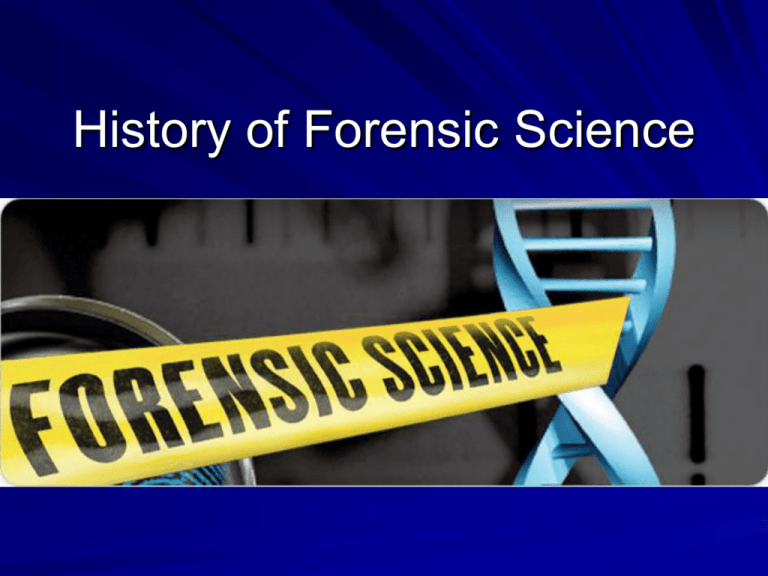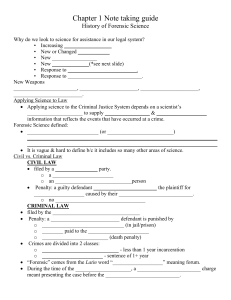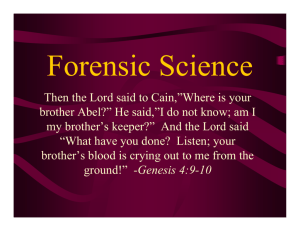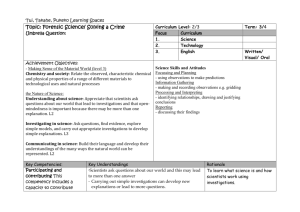History & Development of Forensic Science
advertisement

History of Forensic Science Why do we look to science for assistance in our legal system? • • • • • • Increasing Crime Rates New or Changed Laws New Crimes New Weapons Response to Public Concerns Response to Law Enforcement Concerns Crime Rate Computer software was used to graphically represent the amounts of different categories of crimes in and around San Francisco: Applying Science to Law Applying science to the Criminal Justice System depends on a scientist’s ability to supply accurate & objective information that reflects the events that have occurred at a crime. Forensic Science defined: Forensic Science (or Criminalistics) is the use of science & technology to enforce civil & criminal laws. It is vague & hard to define b/c it includes so many other areas of science. Civil vs. Criminal Law CIVIL LAW filed by a private party. o a corporation o an individual person Penalty: a guilty defendant pays the plaintiff for losses caused by their actions. o no incarceration Civil vs. Criminal Law CRIMINAL LAW filed by the government Penalty: a guilty defendant is punished by o incarceration (in jail/prison) o fine paid to the gov’t o execution (death penalty) Crimes are divided into 2 classes: o misdemeanors - less than 1 year incarceration o felonies - sentence of 1+ year History & Development of Forensic Science When in Rome… “Forensic” comes from the Latin word “forensis” meaning forum. During the time of the Romans, a criminal charge meant presenting the case before the public. Both the person accused of the crime & the accuser would give speeches based on their side of the story. The individual with the best argumentation would determine the outcome of the case. Major Contributors to Forensic Science: Marcello Malphighi - 1686 First recorded notes about fingerprint characteristics. However he did not acknowledge their value as a method of identification. Carl Wilhelm Scheele – 1775 Devised the first successful test for detecting the poison arsenic in corpses. Sir Arthur Conan Doyle Sci-fi author in late 1800’s Popularized scientific crime-detection methods through his fictional character ‘Sherlock Holmes’. Mathieu Orfila (1787-1853) “Father of Toxicology” Wrote about the detection of poisons & their effects on animals. 1814 – published the first treatise on detection of poisons and their effects on animals. Alphonse Bertillon (1879) “Father of Anthropometry” Developed a system to distinguish one individual person from another based on certain body measurements. Anthropometry is a systematic procedure for taking body measurements as a means of distinguishing one individual from another. Francis Galton (1822-1911) “Father of Fingerprinting” Developed fingerprinting as a way to uniquely identify individuals. Francis Henry Galton – 1892 – published the book, “Finger Prints,” which contained the first statistical proof supporting the uniqueness of his method of identification. Cousin of Charles Darwin. Hans Gross – 1893 Published the book, “Criminal Investigation,” which detailed how to use microscopy, chemistry, physics, mineralogy, botany, zoology, etc. in crime scene investigation. Dr. Karl Landsteiner – 1901 Discovered that blood could be grouped into different categories (ABO). Leone Lattes (1887-1954) “Father of Bloodstain Identification” He developed a procedure for determining the blood type (A, B, AB, or O) of a dried blood stain. Dr. Leon Lattes – 1915 – Devised a simple test to determine the blood group of dried blood. Albert S. Osborn – 1910 Pioneer in document examination, published his book, “Questioned Documents.” His work led to the acceptance of documents as scientific evidence by the courts. Edmond Locard – 1910 Set up the first crime lab in an attic of a police station. With few tools, he quickly became known world-wide to forensic scientists & criminal investigators & eventually founded the Institute of Criminalistics in France. Edmond Locard His most important contribution was the “Locard’s Exchange Principle” - It is impossible for a criminal to act considering the intensity of the crime, without leaving a trace. Locard’s Exchange Principle “Every Contact Leaves a Trace.” He believed that every criminal can be connected to a crime by particles carried from the crime scene. When a criminal comes in contact with an object or person, a cross-transfer of evidence occurs. Walter C. McCrone (1916 - 2002) “Father of Microscopic Forensics”. Became the world’s preeminent microscopist. He developed & applied his microscope techniques to examine evidence in countless court cases. Calvin Goddard (1891-1955) “Father of Ballistics” Developed the technique to examine bullets, using a comparison microscope, to determine whether or not a particular gun fired the bullets. Calvin Goddard – Refined techniques of firearms examination including microscopic examination. J. Edgar Hoover “Father of the FBI” Director of Federal Bureau of Investigation during the 1930’s Hoover's leadership spanned 48 yrs & 8 presidential administrations. His reign covered Prohibition, the Great Depression, WWII, the Korean War, the Cold War, & the Vietnam War. He organized a national laboratory to offer forensic services to all law enforcement agencies in the U.S. VERY CONTROVERSIAL He exceeded & abused his authority with unjustified investigations & illegal wiretaps based on political beliefs rather than suspected criminal activity. FBI directors are now limited to 10-year terms . Sir Alec Jeffreys – 1984 First DNA profiling test. English molecular biologist and discoverer of DNA fingerprinting. He is holding the original autoradiogram that led to his discovery of the technique in 1984. Applications of Forensic Science Identification of Criminals or Victims Solving Mysteries Past crimes (unsolved or wrongfully convicted). Cause, Location, Time of Death. Paternity cases. Cyber crimes. Corporate Crimes (Enron). Voice Analysis. Applications of Forensic Science Application of DNA as evidence. Prevention vs. Reaction. Catastrophes & Wars ID remains of victims (either civilian or soldiers) ex. Holocaust or Katrina Military & International Forensics Terrorism. The search for WMD’s. stockpiled or stored weapons from past wars. Munitions When the Army unearthed more than a 1,000 mortar rounds from a WW2 training site, they enlisted a Forensic Science Lab to determine which were live munitions & which were dummies. The Trial of the Century O.J. Simpson was a NFL football legend. He is now famous for having been tried for the murder of ex-wife Nicole Brown Simpson & her friend Ronald Goldman in 1994. He was acquitted in criminal court after a lengthy, highly publicized trial. What went wrong? 1st on the scene, police found evidence of blood & entered the Simpson home without a search warrant, an action permissible b/c the situation was an emergency. HOWEVER, the police collected a pair of bloodstained gloves during their search. Collection of evidence without proper warrants became the key argument used by Simpson’s legal team & ultimately led to his acquital. What was learned? If forensic evidence is to be admissible in court, the highest professional standards must be used at the crime scene! He was found liable for their deaths in civil court, but has yet to pay the $33.5 million judgment. THE BODY FARM PRIMARY GOAL: To understand the processes & timetable of postmortem decay, primarily to improve determining the "time since death" in murder cases. The Body Farm is a simulation of various crime scenes using real human bodies. Started in 1970-80’s to study Forensic Anthropology (the study of human decomposition after death). THE BODY FARM Used by Law Enforcement, Medical Examiners, Entomologists, Cadaver Dogs, Anthropologists & FBI for Crime Scene Training. The BF uses unclaimed cadavers & volunteers (who donate their body to science after death) Only 2 Facilities in the U.S. Univ. of Tennessee (original) Western Carolina University Texas State University - local residents opposed it Doorway to death, the main gate of the Anthropology Research Facility—the “Body Farm”—consists of a wooden privacy fence inside a chain-link fence that’s topped with razor wire. Security is a high priority. Fences, padlocks, video surveillance cameras, & police patrols safeguard the world’s only humandecomposition research facility. One research study examined the effects of the elevated temperatures—and limited insect access—to which a body in a car would be subjected. Corpse 1-81 was an elderly white male; he became part of a pioneering study of insect activity in human corpses. Closeup of a recent research subject. After only a few weeks in the Tennessee summer, the skull is completely bare & many vertebrae are exposed. The rib cage & pelvis are covered with dried, leathery skin, but the soft tissues beneath are gone, consumed by insects & bacteria. Close-up of a human femur & hip bone, containing an artificial hip implant. Such orthopedic devices can help identify an unknown crime victim. An aerial view of the Body Farm, taken from Patricia Cornwell’s helicopter. The large wooden tripods are used for hoisting & weighing bodies as part of a research study of weight loss during decomposition. A jaw from a research subject held by the founder of the Body Farm.









